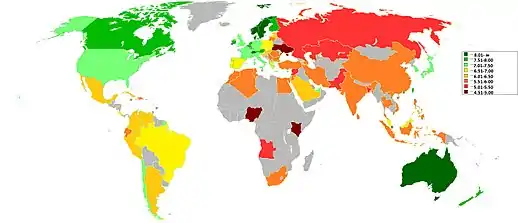Where-to-be-born Index
The Economist Intelligence Unit’s where-to-be-born index (previously called the quality-of-life index, abbreviated QLI) attempts to measure which country will provide the best opportunities for a healthy, safe and prosperous life in the years ahead.

It is based on a method that links the results of subjective life-satisfaction surveys to the objective determinants of quality of life across countries along with an onward-looking element.
Methodology
The index calculated for 2013 includes data from 80 countries and territories. The survey used ten quality of life factors along with forecasts of future GDP per capita to determine a nation's score.[1]
The life satisfaction scores for 2006 (on a scale of 1 to 10) for 130 countries (from the Gallup Poll) are related in a multivariate regression to various factors. As many as 11 indicators are statistically significant. Together these indicators explain some 85% of the inter-country variation in life satisfaction scores. The values of the life satisfaction scores that are predicted by the indicators represent a country's quality of life index. The coefficients in the estimated equation weight automatically the importance of the various factors. The estimated equation for 2006 can be utilized to calculate index values for year in the past and future, allowing for comparison over time as well across countries.[2]
The independent variables in the estimating equation for 2006 include:
- Material well-being as measured by GDP per capita (in $, at 2006 constant PPPS)
- Life expectancy at birth
- The quality of family life based primarily on divorce rates
- The state of political freedoms
- Job security (measured by the unemployment rate)
- Climate (measured by two variables: the average deviation of minimum and maximum monthly temperatures from 14 degrees Celsius; and the number of months in the year with less than 30mm rainfall)
- Personal physical security ratings (based primarily on recorded homicide rates and ratings for risk from crime and terrorism)
- Quality of community life (based on membership in social organizations)
- Governance (measured by ratings for corruption)
- Gender equality (measured by the share of women holding seats in national Houses of Assembly)
See also
Measurement and metrics
Indices
- Canadian Index of Wellbeing
- Bhutan GNH Index
- Broad measures of economic progress
- Disability-adjusted life year
- Full cost accounting
- Green national product
- Green gross domestic product (Green GDP)
- Gender-related Development Index
- Genuine Progress Indicator (GPI)
- Global Peace Index
- Gross National Happiness
- Gross National Well-being (GNW)
- Happiness economics
- Happy Planet Index (HPI)
- Human Development Index (HDI)
- ISEW (Index of sustainable economic welfare)
- Legatum Prosperity Index
- Leisure satisfaction
- Living planet index
- Millennium Development Goals (MDGs)
- Money-rich, time-poor
- OECD Better Life Index BLI
- Subjective life satisfaction
- Where-to-be-born Index
- Wikiprogress
- World Happiness Report (WHR)
- World Values Survey (WVS)
Notes
- "The Lottery of Life: Where to be Born in 2013". The Economist. 21 November 2012.
- "The Lottery of Life Methodology: How we Calculated Life Satisfaction". The Economist. 21 November 2012.